Berdimuminova Zulfiya Zafar qizi 1 , Zohidova Guzal Elbekovna2

DOI: https://doi.org/10.5281/zenodo.15255215
Google scholar: https://scholar.google.com/scholar?hl=ru&as_sdt=0%2C5&q=%22CREATIVE+WAYS+OF+TEACHING+ENGLISH+IN+KINDERGARTEN%22&btnG=
Zenodo community: https://zenodo.org/records/15255215
Nordic_press journal: https://research.nordicuniversity.org/index.php/nordic/article/view/2386
MAQOLANI YUKLAB OLISH
SERTIFIKATNI YUKLAB OLISH
REVIEW:
Zulfiya Berdimuminova’s article presents a thoughtful and practical exploration of innovative strategies for teaching English to young children in kindergarten settings. The work stands out for its clarity, relevance, and pedagogical value, especially in the context of early childhood education where engagement and creativity are essential for successful learning outcomes.
The article effectively outlines the theoretical foundation for teaching English to young learners by referencing key scholars such as Phillips, Gardner, and Elkind. These theoretical insights are complemented by hands-on strategies like flashcard games, storytelling, songs, role-playing, and Total Physical Response (TPR), all of which are well-explained and justified within the text. The integration of visual, auditory, and kinesthetic learning techniques demonstrates the author’s understanding of multiple intelligences and child-centered learning.
One of the article’s notable strengths is its emphasis on interactive learning and the use of play-based approaches. The author not only explains why such methods are effective but also provides detailed examples and practical applications, making this work especially useful for novice educators or those seeking to revamp their classroom strategies.
The section on illustrated stories and songs is particularly commendable for highlighting the link between creativity and language retention. The article also supports its claims with recent research and statistics, which adds academic credibility and depth to the discussion.
However, some areas could benefit from refinement. For instance, the writing could be improved through clearer transitions between sections and slightly more concise language to enhance readability. In future versions, adding examples of real classroom case studies or teacher testimonials could further enrich the practical impact of the work.
Conclusion
Overall, this article makes a meaningful contribution to the field of early childhood language education. It bridges theory with practice, offering both foundational insights and real-world strategies for making English learning enjoyable and effective for kindergartners. Berdimuminova's work is both timely and pedagogically sound, making it a valuable resource for teachers, educational researchers, and curriculum developers alike.
Recommendation: Recommended for publication or presentation in academic conferences and journals focusing on TEFL, early childhood education, or innovative pedagogy.



